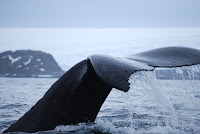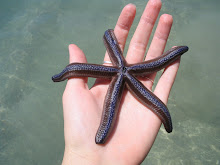The mountains alone are a separate highlight at the top of my list. Never did I think about seeing huge, tall mountains covered in snow and surrounded by water. I will never get over the odd and incredible impressions that dominating aspect of the landscape gave me. Completely captivating. A third feature of the landscape that I loved were the sunsets. Perhaps because they were rare or perhaps because sunsets are something that everyone can relate to, I'm not sure which. What made these sunsets special, though, were the icebergs that littered the foreground and how the low-lying clouds around the mountains were tinted orange. Sometimes the sunset glued all of the pieces together in my mind - the water, the ice, the rocks, the mountins, and our place in it.
Something else I will unquestionably take with me is all of the wildlife that gives personality to the landscape. I cannot believe all of the marine animals I saw and got close to. The whales, the penguins, the seals.... all of it was awesome. That brings me to camping. I described it in an earlier post, but that feeling of being surrounded by raw, unadulterated nature is something that I never want to forget even though there is little room for that sentiment in "the real world."
One aspect of this landscape that will stay with me is its expansiveness. Perhaps it is so evident because of the tall mountains, or maybe because you can look to the horizon and see it as your domain because nobody can ever claim it or develop it. I always try to observe my surroundings in all of their detailed complexity but I try to simultaneously see myself as the dot that I am. This was particularly easy sitting atop the glacier looking at the mountains that vanish into the distance not because of foggy clouds but because they actually keep going as far as you can see. The only way that I can think to convey the beauty of this expansiveness would be to tell you to close your eyes and create a mental collage of all of my photographs and allow that stitched image to extend infinitely to the horizon. I know that's what I'm going to do when I am surrounded by billboards and traffic lights.
Hugh says that the real world will never be the same. I'm not convinced that this is true, but it does beg the question of how much of all this I will be able to carry with me. I know that you cannot hold onto everything in life, but I cannot help but think that this experience has changed me. The problem is that when old routines and habits set in, your current circumstances really dominate your past experiences - even if they are incredible, they tend to melt away. Perhaps the two things that I am determined to bring with me are the positivity and the peace that I have felt. Being so excited on a daily basis completely trumps all other rollercoaster feelings that are a part of life - it's a constant emotional high. When I tried to figure out why being at Palmer station was so easy for me, I came up with two things: no money, no cars. Never worrying about finances or sitting in traffic is a beautiful thing and it actually gives you the opportunity to see what you become when stripped of the usual concerns.
All that said, when people kept asking me whether I'd be back or want to be back, the answer was far from a no-brainer. Living in Antartica gives you so much, but you have to give up almost everything in return. It works for some people. A notable Antarctic researcher once said that if you shake the earth, all the misfits fall to the bottom. I don't think that's entirely true, but you can look around and understand why certain people are just happier here. Speaking of people, the community that I found at Palmer is perhaps highest on my list of unforgettables! I will never forget the smiles and generosity that I met here. Working here felt very really and meaningful, but some might see Antarctica as an escape from everything. I'm not sure how my own perspective on this will change with distance, but maybe it's a little of both. My biggest hope is that there will always be a space inside of me where I can go to relive this incredible adventure. Through this trip, I have been reminded of how important it is to let my imagination run free and allow my heart and mind to simply explore the world.
Thanks to my friends and family who have been following me in all of this - it means a lot. An even bigger thanks to my bunkmate, travel and gym buddy, my partner in exploration, laughter and microbrial crime, the one and only, Alice Alpert. This wouldn't have been the same without you for a companion!
Oh, Antarctica, it's been great - I owe you one.








































